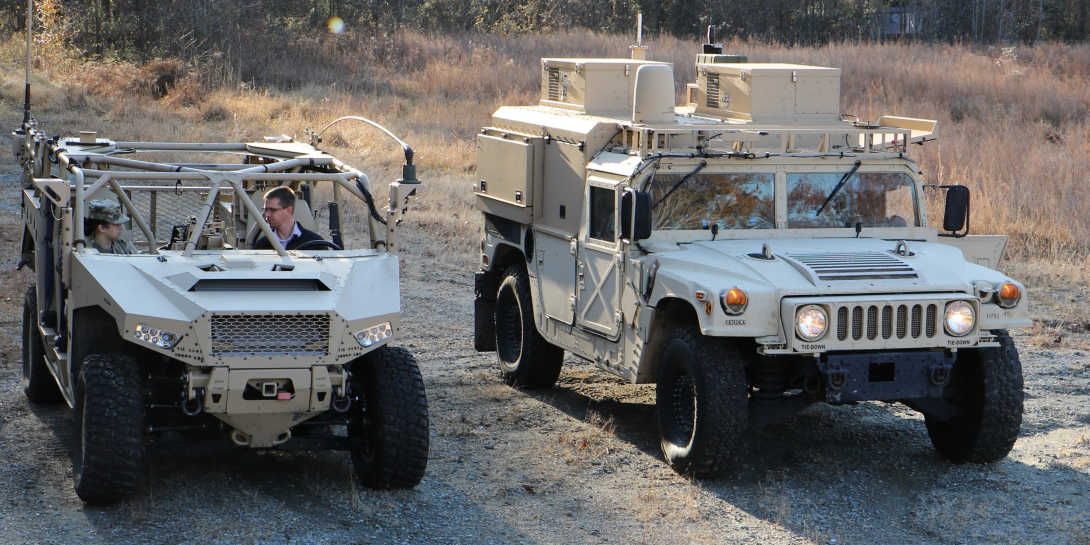Army Microgrid To Power Multidomain Operations
U.S. Army researchers plan to demonstrate in December and March capabilities that could lead to a secure, mobile power grid capable of automatically providing electricity from the best available source, including batteries, vehicles or diesel generators.
The so-called microgrid will integrate multiple power sources to achieve optimum power performance, improving power distribution, storage, monitoring and maintenance. “This is the first demonstration of future battlefield power, our universal battlefield power, UBP,” says Thomas Bozada, senior project manager, U.S. Army Corps of Engineers and co-technical manager for the Secure Tactical Advanced Mobile Power (STAMP) joint capability technology demonstration. “That’s the ability of the commander to utilize any power source on the battlefield whether it’s traditional generators, energy storage, vehicles with onboard exploitable power, and eventually host-nation power.”
Ultimately, the capability will enable multidomain operations, the researchers emphasize. “One of the underpinning concepts when we talk about being contested in the different domains is having reliable power. When we look at various sets of technologies, a common theme throughout is ‘no power, no technology, no capability,’” says Michael Gonzalez, lead for the Power Management Team within the Army’s Command, Control, Communications, Computer, Cyber, Intelligence, Surveillance and Reconnaissance (C5ISR) Center, and co-technical manager for STAMP. “We need a power architecture that’s going to do that, that’s going to enable that warfighter the capability to create multiple solutions.”
The STAMP program is based on science and technology products from the Army’s Energy Informed Operations program. The effort officially kicked off in June, and it involves organizations from across the Defense Department, including: U.S. Indo-Pacific Command, U.S. Central Command, U.S. Transportation Command, Army Project Manager Expeditionary Energy and Sustainment Systems, Army Project Manager Mission Command, Marine Corps Expeditionary Energy Office, Terminal High Altitude Area Defense Program and the Missile Defense Agency, according to an Army announcement published earlier this year.
The program also will provide logistics benefits. “If I’m a warfighter … it’s effectively increasing my range and duration. It’s decreasing my logistical footprint. It’s reducing the number of static generators that I’m going to need to carry on the battlefield, and that in turn reduces my fuel consumption, reduces the amount of maintenances I’m doing and the number of spare parts I’m carrying, and it enables me to take those soldiers or Marines and apply them in tasks that are more traditionally warfighting in nature and less in terms of support,” Bozada says.
The microgrid will be made up of multiple components, including vehicles capable of “exporting” power, some of which could be electric or unmanned vehicles; inverters, which change direct current to alternating current and vice versa; energy storage devices, which will primarily include batteries; cyber secure microgrid controllers and a dashboard to provide situational awareness of the grid.
The microgrid also will be enabled by a Tactical Microgrid Standard, which will provide the integrating architecture. “The Tactical Microgrid Standard is a common way for all these components to talk to each other,” Gonzalez notes.
No vehicles in the current fleet are able to convert alternating current (AC) to direct current (DC) and export that DC power, so either translation devices or software updates will ultimately be required for microgrid standard compliance. Test vehicles include the Family of Medium Tactical Vehicles and the hybrid electric version of the M99 Heavy Extended Mobile Tactical Truck.
“We harness that direct current power through something we’ll call a universal inverter technology that’s able to take DC power and put it onto AC,” Gonzalez explains. “By doing that, we are now able to tie in DC sources, which is not only vehicles but also batteries, also [photovoltaic] and many other things that are renewable power sources or new capabilities.”
Future vehicles will contribute significantly to the microgrid. “At some point in the future, ideally sooner rather than later, we’re going to have electric vehicles and possibly autonomous vehicles on the battlefield. Typically, we would think of that electronic vehicle as a DC load. I have to charge it, and I need a tactical charging capability to do that. That’s one of the things we’re demonstrating in the joint concept technology demonstration,” Bozada reports. “But that vehicle itself can have different personalities. Its primary mission can be as a tactical vehicle, and I want to keep it charged at 100 percent, just like we keep our vehicles fueled at 100 percent whenever we stop. But if I know that vehicle’s not going to move, which is often the case in a contingency environment, I might plug it into the grid and let it supply grid support.”
The microgrid also is designed to be resilient. If a generator needs to be removed from the grid, for example, the remaining components continue operating.
The three-year program is currently in the technology preparation phase. Researchers say it is premature to name specific dates for the demonstrations, but one will likely be in the laboratory, the other in the field with soldiers involved.
“We have a demonstration coming up to show hybrid technologies, so basically batteries, energy storage and diesel generators, and through an [Office of the Secretary of Defense]-funded effort, the Rapid Reaction Technologies Office has funded an effort that allows us to explore vehicles coming together and connecting power-wise,” Gonzalez reports.
If the joint tactical concept demonstration is successful at the end of three years, the technologies could transition to the Project Manager for Expeditionary Energy and Sustainment Systems and the Program Manager-Transportation Systems for fielding.





Comments